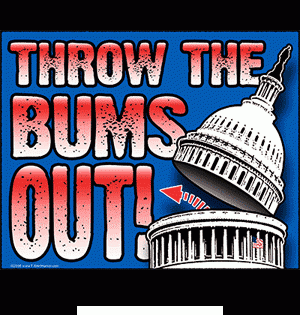Primary elections originated in the American progressive movement and were intended to take the power of candidate nomination away from party leaders and deliver it to the people. California's Top Two Primary takes power away from third parties representing the 99% and delivers it to the 1%.
Voters have increasingly become disillusioned with the Democratic and Republican Parties. According to a poll reported by Rasmussen in April, more than half the country believes that neither of the top two parties represents the American people.As presidential candidate Ron Paul remarked in 2011:
These parties aren't different, they're all the same. The monetary policy stays the same. The welfare system stays the same. The foreign policy stays the same. . . . There is but one party.
Or as Ronald Reagan put it, "We don't need a third party. We need a second party."
A recent Gallup poll found that nationwide, the share of registered voters identifying as independent has hit a record high of 42 percent. That trend also holds true in California. Yet no third-party or independent candidate for state-wide office will appear on the California general election ballot in November. All were eliminated by Top Two, the new electoral system ushered in by Proposition 14 in 2010. It excludes all but the top-two primary vote-getters from advancing to November, and that effectively means all but the top two political parties.
In the June 3rd California primary, the highest number of votes received by any third party or independent candidate was 218,847, representing 6.4% of voters. That count went to me, running as a Green for state treasurer on a state bank platform. It was the highest percentage ever gotten by a Green in a statewide partisan California election, but it was not enough to leap the top-two barrier. Laura Wells, also running as a Green on a state bank platform, received 5.6% of the vote for state controller. All other third party and independent statewide candidates got a lower percentage in their races, except for one independent who just placed fourth. That means only Democrats and Republicans will be debating the issues in November.
Top Two has not only foreclosed third-party candidates from the general election but has made it substantially harder for them to get on the primary ballot. From 1992 to 2010, the Green, Libertarian, Peace and Freedom, and American Independent parties averaged 127 primary ballot candidates among them in each election cycle. In 2012, in Top Two's first year, they were able to qualify only 17 for state legislative and congressional races, the fewest since 1966, when only Democrats and Republicans were on the ballot. This dropped to 13 in 2014, with only 10 others running for quadrennial statewide offices, down from 33 in 2010.
California's Controversial Proposition 14
On Feb. 19, 2009, between 4 and 7 a.m., without any public notice or public hearing, the Legislature placed a major constitutional electoral reform -- Proposition 14 -- on the June 2010 primary ballot and approved its companion statute, Senate Bill 6.
The Voter Information Guide did not provide a summary or text of SB 6, which fleshes out critical details of Proposition 14; nor did Proposition 14's official ballot title and summary refer to it. Many potential negative effects of Top Two were hidden from voters, and opportunities to vet and correct them before the measure was placed on the ballot were denied to the public.
This left the field wide open for California's largest corporations -- which enthusiastically favored Proposition 14 because they thought it would result in the election of corporate-friendly public officials -- to flood the airwaves with propoganda about how Top Two would increase voter choice. In fact, it has done the opposite, to the point of excluding "no corporate money" candidates from the general election debate.
Several other barriers to participation were added or strengthened by Top Two, without the prior vetting of voters. The number of signatures needed to be on the statewide primary ballot without paying an expensive filing fee jumped from 150 to 10,000 for smaller-party candidates -- and that puts the candidate on the ballot only for the June primary, not into November as under the previous system.
Meanwhile, the fee for a candidate statement in the Voter Information Guide -- the chief way many voters learn about candidates -- was raised to $25 per word, putting the cost of a full statement at more than double the candidate filing fee. The result was to radically reduce the number of words many smaller-party candidates can afford.
The Legislature even eliminated general election write-in candidacies -- a right Californians have enjoyed since statehood in 1850.
By eliminating party primaries, Top Two increased the cost of running for office -- and the need for early big money -- for candidates from all parties. Candidates now have to campaign to the entire electorate in June as well as in November (assuming they manage to reach the general election). That means the role of money in California politics has only increased as a result of Top Two, making it even easier for "the 1%" to buy elections.
(Note: You can view every article as one long page if you sign up as an Advocate Member, or higher).






